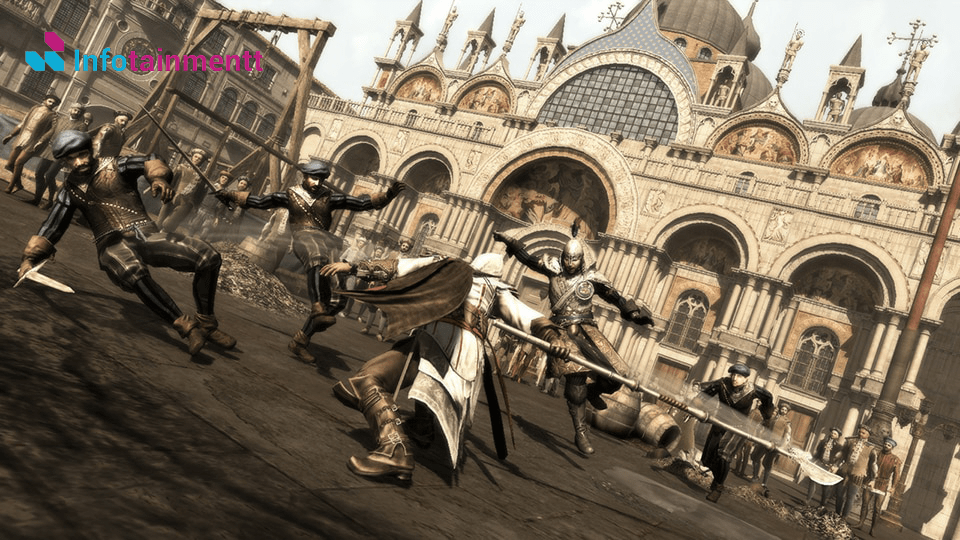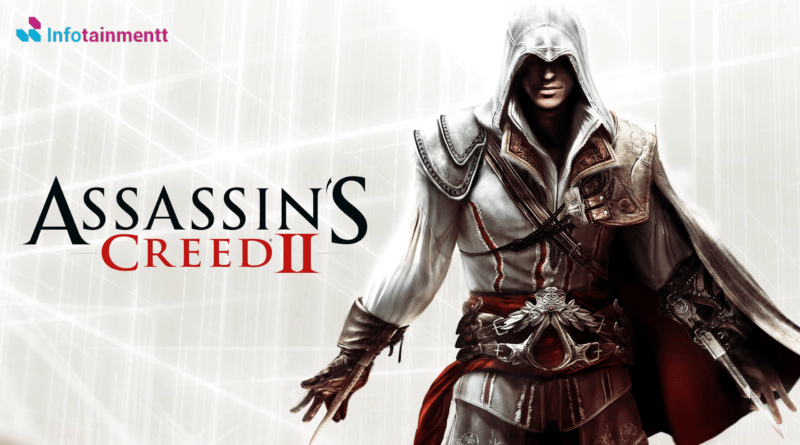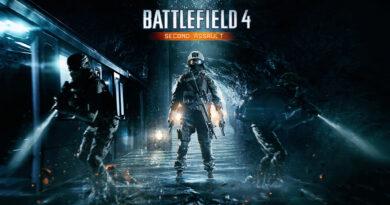Free Download Assassin’s Creed II | Download Assassin’s Creed II
Table of Contents
Free Download Assassin’s Creed II
You can easily Free Download Assassin’s Creed II For PC here.
Ubisoft Montréal developed and Ubisoft published Assassin’s Creed II, a 2009 action-adventure video game. Serving as the second major installment in the Assassin’s Creed series, it is a sequel to the 2007 title, Assassin’s Creed. Originally launched on the PlayStation 3 and Xbox 360 in November 2009, the game became available on Microsoft Windows in March 2010 and OS X in October 2010. The remastered versions of Assassin’s Creed II, along with its two sequels, Assassin’s Creed: Brotherhood and Assassin’s Creed: Revelations, were collectively released as The Ezio Collection compilation on November 15, 2016, for the PlayStation 4 and Xbox One. The Nintendo Switch version was released on February 17, 2022.
The game unfolds in a fictionalized historical context, weaving through real-world events, depicting the age-old conflict between the Assassins, champions of peace and free will, and the Templars, proponents of control for the sake of peace. The overarching narrative is framed in the 21st century, where Desmond Miles revisits the genetic memories of his ancestor, Ezio Auditore da Firenze. Desmond’s quest is to unravel the enigmas left behind by the ancient First Civilization, to put an end to the ongoing Assassin-Templar strife.

The primary storyline transpires during the Italian Renaissance, specifically from 1476 to 1499, and follows Ezio’s evolution as an Assassin. His journey is fueled by a quest for vengeance against those accountable for the death of his father and brothers. The gameplay centers around leveraging Ezio’s combat prowess, stealth skills, and parkour abilities to conquer foes and navigate the intricacies of the surroundings.
Set against a meticulously recreated open world, the game encompasses various Italian cities such as Florence, Venice, Monteriggioni, San Gimignano, and Forlì. These locales authentically capture the historical essence of the Renaissance era within the game.
Assassin’s Creed II commenced development shortly after the release of its predecessor, Assassin’s Creed, utilizing the newly updated Anvil game engine. As part of the game’s promotional strategy, Ubisoft unveiled a three-part live-action short film called “Assassin’s Creed: Lineage.” This film, functioning as a prequel to the main storyline, features the majority of the game’s cast.
Throughout the development phase, two chapters named “The Battle of Forlì” and “Bonfire of the Vanities” had to be excluded from the main game due to time constraints. However, they were later introduced as downloadable expansion packs on Xbox Live and subsequently on other platforms.

As an added incentive for players, Ubisoft incorporated in-game bonuses, including missions, outfits, and weapons, which could be unlocked through Ubisoft’s Uplay service. This practice became a recurring trend in many Ubisoft titles moving forward.
Upon its debut, Assassin’s Creed II garnered widespread critical acclaim from video game publications. The game received accolades for its compelling narrative, well-developed characters, intricately designed world, and notable improvements over its predecessor. However, the PC version faced scrutiny due to issues related to the digital rights management system, leading to the permanent removal of the always-online DRM feature.
Regarded as one of the finest video games ever created, Assassin’s Creed II achieved remarkable success by surpassing nine million copies in sales within six months of its release. It is often recognized as the title responsible for propelling the Assassin’s Creed series into mainstream popularity. The game catalyzed two direct sequels, namely Assassin’s Creed: Brotherhood (2010) and Assassin’s Creed: Revelations (2011), along with a spin-off titled Assassin’s Creed II: Discovery (2009). These installments further expanded upon Ezio’s narrative, introducing fresh plotlines, characters, and locations.
The subsequent numerical entry in the series, Assassin’s Creed III, was subsequently launched in 2012.
Assassin’s Creed II Gameplay
Assassin’s Creed II offers an action-adventure experience presented in a third-person perspective within an open world inspired by late 15th-century Renaissance Italy. The game features a nonlinear approach, emphasizing hack-and-slash combat, stealth, and exploration.
Introducing the Animus 2.0, an upgraded version of the machine from the original Assassin’s Creed, this device provides in-game context for alterations and additions to various game elements. Players can access a database containing additional historical information about significant landmarks, characters, and services encountered throughout the game.
The health system has been enhanced for greater dynamism, linking it to synchronization with the Animus. As a result, the character only recovers from minor injuries. More severe injuries necessitate a visit to a street-side doctor or the use of medicine, which can be acquired either from doctors or found on bodies.
In Assassin’s Creed II, players can now engage in swimming activities, and the Eagle Vision, a skill allowing the identification of specific individuals and landmarks, is now usable in third-person view and while on the move. The game features a young Leonardo da Vinci, who assists the player by crafting new weapons using translated “Codex pages” left behind by Altaïr, the main character from the original game.
Leonardo’s flying machine, inspired by real-life airplanes, plays a role in a particular mission. Various modes of transportation are available, such as horses, exclusively ridden outside major cities, gondolas, prevalent in Venice, and a carriage, utilized in a mission involving Leonardo. The game’s locations are more intricately detailed compared to its predecessor, and non-playable characters exhibit more realistic behavior, including instances of civilians coughing or sneezing.
Players can also enlist the services of mercenaries, courtesans, or thieves to combat, distract, or lure guards, respectively. The inclusion of a day and night cycle adds a temporal dimension to the game, influencing mission settings and events based on specific times of the day.

Numerous methods exist for interacting with non-playable characters (NPCs) in the game. Money can be tossed onto the ground, or a carried corpse can be deposited, serving as a distraction for both guards and peasants. Various types of enemies, differing in agility and strength, are present, with some actively searching hiding places where Ezio was last observed. Additionally, during combat, the player has the option to mock an enemy.
The combat system in Assassin’s Creed II is more intricate than its predecessor, allowing players to disarm opponents through counter-attacks while unarmed. If the player manages to steal an enemy’s weapon, they can execute an immediate attack resulting in the enemy’s instant demise.
Leonardo provides the player with specialized weaponry, including dual hidden blades, poison blades, and the hidden gun (a miniature wheellock firearm), all derived from schematics found in Altaïr’s Codex pages. Various weapons like generic swords, cutlasses, maces, axes, and daggers can be purchased from vendors in each city.
Players can also utilize improvised weapons found on the ground, such as brooms or halves of a spear. Additionally, players have the option to acquire artwork for their villa, upgrade Ezio’s armor throughout the game, and even dye his clothing in a variety of colors. Other equipment includes larger pouches for carrying more throwing knives and medicine. In the PlayStation 3 version, connecting the console to a PlayStation Portable containing Assassin’s Creed: Bloodlines unlocks six additional weapons.
The Auditore family’s rural villa, situated in Monteriggioni, serves as Ezio’s base of operations. The surrounding estate, which includes vendors offering items like medicine, weapons, and clothing dyes, can be enhanced through the use of earned florins.
Upgrades not only provide Ezio with discounts at the shops but also boost the passive income generated by the villa over time. This accumulated income is stored in a chest within the villa and requires regular collection. The villa’s overall value increases with the purchase of upgrades for Ezio and paintings.

The game introduces a more diverse range of methods for hiding or blending into the surroundings. Players can now dive underwater to break guards’ line of sight, and blending can be executed with any group of people, rather than being restricted to a specific type as in the first Assassin’s Creed.
A notoriety system is featured, where guards become more vigilant of Ezio based on his behavior, location, and current mission. Players can diminish this infamy through bribery, removal of wanted posters, or the assassination of corrupt officials.
The game now offers a more diverse range of missions with varied structures. For instance, a mission might begin with the objective of escorting someone, only to transition into a chase and assassination scenario. Investigations are less explicit, and missions may involve following individuals or unfolding narratives.
With approximately 150 missions in the game, two-thirds are integral to the main storyline, while the remainder comprises optional side quests, including assassination contracts and races. Within cities, players can discover concealed locations like catacombs and caves, the designs of which developers have likened to those in the Prince of Persia series.
Navigating these areas rewards players with Assassin’s Seals, and collecting all six allows access to the Armor of Altaïr, stored in a hidden section of the Villa.
Similar to Assassin’s Creed, the game features characters inspired by historical figures, including Leonardo da Vinci, Niccolò Machiavelli, Caterina Sforza, Bartolomeo d’Alviano, the Medici family, the Pazzi family, the Barbarigo family, the Loredan family, and Pope Alexander VI. The game’s locations encompass the Tuscany region (Florence, Monteriggioni, and San Gimignano), the Apennine Mountains, the Romagna region (Forlì), Venice, and the Vatican (only accessible during the final mission).
Assassin’s Creed II Trailer
Assassin’s Creed II Minimum And Maximum System Requirements
Minimum System Requirements:
- OS: Windows XP (32-64 bits) / Windows Vista (32-64 bits) / Windows 7 (32-64 bits)
- Processor: Intel Core 2 Duo 1.8 GHz or AMD Athlon X2 64 2.4 GHz
- Memory: 1.5 GB for Windows XP / 2 GB for Windows Vista and 7
- Graphics: 256 MB DirectX 9.0-compliant card with Shader Model 3.0 or higher (see supported list)
- DirectX: DirectX 9.0
- Hard Drive: 8 GB free space
- Sound: DirectX 9.0-compliant sound card
Recommended System Requirements:
- Processor: Intel Core 2 Duo E6700 2.6 GHz or AMD Athlon 64 X2 6000+ or better
- Memory: 2 GB
- Graphics: GeForce 8800 GT or ATI Radeon HD 4700 or better
- DirectX: DirectX 9.0-compliant card with Shader Model 3.0 or higher (see supported list)
- Hard Drive: 8 GB free space
- Sound: 5.1 sound card



